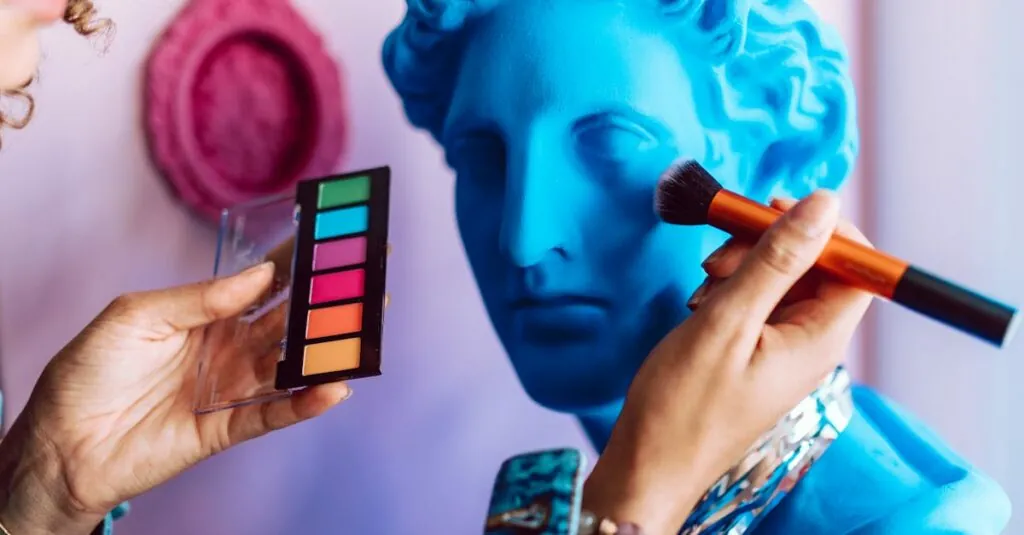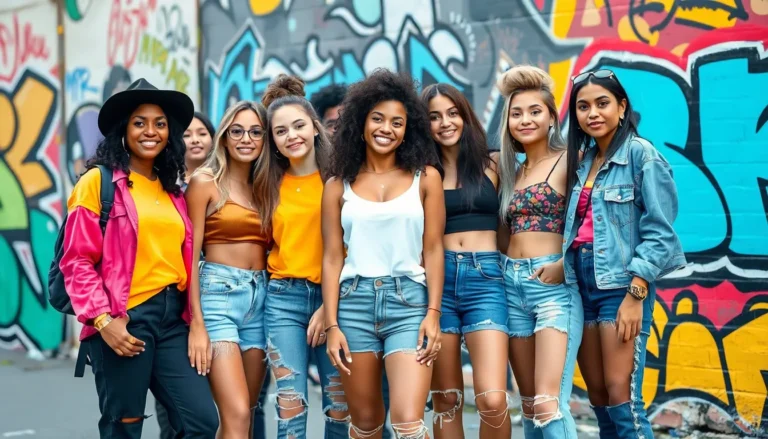Table of Contents
ToggleGen Z is shaking up the design world like a TikTok dance challenge. With their unique blend of creativity and digital savvy, this generation isn’t just following trends; they’re setting them. From bold colors to nostalgic aesthetics, they’re redefining what it means to be stylish in a fast-paced, ever-evolving landscape.
Overview of Gen Z Design Trends
Generation Z influences design trends through a distinct mix of creativity and digital proficiency. Bright, bold colors dominate their aesthetic preferences, often juxtaposed with retro elements. Designs reflect an appreciation for nostalgia, seamlessly blending modern and vintage inspirations. Sustainable practices also play a crucial role in their choices, with many favoring eco-friendly materials and designs.
Typography stands out as another focal point. Unique fonts and playful typography capture attention, reinforcing brand identity and engagement. The use of digital tools enables them to experiment with these elements effortlessly, pushing boundaries in visual communication.
Interactive design captures their interest significantly. Features like gamification and augmented reality enhance user experiences, inviting deeper connections with the content. This engagement reflects their desire for participation and active involvement.
Inclusivity shapes trends further, emphasizing diverse representation in design. Brands adapting to reflect various identities resonate more with this demographic. Gender-neutral designs and culturally relevant themes foster a sense of belonging and acceptance.
In terms of functionality, minimalism appeals to Gen Z. Clean, organized layouts prioritize user experience while minimizing distractions. Effective use of whitespace emphasizes essential elements, making navigation intuitive.
Understanding these trends enables brands to align their strategies with the evolving preferences of Gen Z. Utilizing a mix of nostalgic flair, sustainable practices, and interactive features addresses their values directly, creating a meaningful connection. Observing these design trends provides insight into a generation that values both aesthetics and functionality.
Key Characteristics of Gen Z Designers
Gen Z designers exhibit unique traits that set them apart in the creative landscape. These characteristics shape their approach to design and influence industry trends.
Emphasis on Sustainability
Sustainability stands as a core principle for Gen Z designers. Many of them prioritize eco-friendly materials and practices, driving demand for brands that demonstrate a commitment to the environment. Biodegradable products, recycled materials, and ethical production methods resonate deeply with this demographic. Designers not only aim to reduce waste but also emphasize meaningful stories about their sustainable choices. Social responsibility in design plays a significant role, as they seek brands that align with their values. The integration of sustainability into the design process speaks to their desire for a positive impact on the planet.
Digital-First Approach
A digital-first approach characterizes the work of Gen Z designers. Embracing technology is second nature; they utilize digital tools for creativity and innovation. Design software, social media platforms, and online collaboration tools enhance their ability to connect and create. Animation, interactive graphics, and virtual reality experiences showcase their expertise in digital mediums. Designers adapt fluidly to emerging trends, fully leveraging technology to drive engagement. As a result, the boundary between the physical and digital worlds often blurs in their projects. This digital savviness facilitates real-time feedback and fosters collaborative processes, enriching the overall design experience.
Popular Aesthetics Among Gen Z
Generation Z’s design preferences showcase a blend of minimalism and maximalism alongside retro nostalgic influences, reflecting their unique tastes.
Minimalism and Maximalism
Minimalism resonates with Gen Z due to its focus on user experience. Clean layouts and effective use of whitespace enhance functionality, allowing users to navigate content intuitively. Conversely, maximalism also captures attention through bold colors, intricate patterns, and diverse textures. This aesthetic expresses individuality, allowing designers to experiment boldly with visual elements. Both trends coexist, providing brand opportunities to cater to various preferences effectively.
Retro and Nostalgic Influences
Retro designs play a significant role in Gen Z’s aesthetic choices. They often embrace styles from the 90s and early 2000s, seeking comfort in familiarity. Vintage color palettes invoke nostalgia, transporting them back to simpler times. Additionally, classic typography enhances the appeal, connecting the past with modern design. These influences signify a desire for authenticity, enabling brands to resonate deeply with this generation’s experiences and memories.
Technology’s Role in Gen Z Design
Technology plays a crucial role in shaping Gen Z design trends. This generation embraces tools that enhance creativity while pushing the boundaries of traditional design.
Use of Augmented Reality
Augmented reality (AR) captivates Gen Z by creating immersive experiences. Brands utilize AR to engage users, offering interactive features that blend the digital and physical worlds. For instance, virtual try-ons in fashion and beauty allow customers to visualize products before purchasing. This engagement not only boosts customer satisfaction but also fosters a deeper emotional connection with the brand. Gamification within AR elements enhances user interaction, transforming simple browsing into an engaging adventure. Overall, the integration of AR reflects Gen Z’s desire for participatory and personalized experiences.
Integration of Social Media
Social media acts as a powerful platform for Gen Z designers. They leverage these platforms to showcase their work and connect with audiences. Instagram, TikTok, and Pinterest serve as vital channels for trend dissemination, enabling rapid sharing and collaboration. Designers frequently draw inspiration from viral content, adapting popular aesthetics to fit their unique style. User-generated content enhances authenticity, allowing brands to resonate with this demographic. Social media facilitates a feedback loop, where trend analysis occurs in real time. This immediacy empowers Gen Z to shape and redefine design trends based on current cultural movements.
Generation Z is undeniably reshaping the design landscape with their unique blend of creativity and technology. Their emphasis on vibrant colors sustainability and inclusivity highlights a desire for designs that resonate on a personal level. As they continue to explore both minimalism and maximalism their work reflects a dynamic approach to aesthetics that caters to diverse preferences.
The integration of interactive elements and social media showcases their innovative spirit and willingness to engage with audiences in meaningful ways. By embracing nostalgia while pushing for modern relevance they’re paving the way for future design trends that prioritize both functionality and emotional connection. As brands adapt to these evolving preferences they’ll find opportunities to connect with this influential generation in impactful ways.







